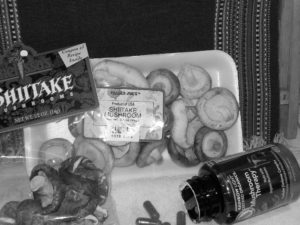Bet on Beta Blucons
When I was a kid, much to the dismay of my mom and her limited food budget, I developed a passion for mushrooms. Later, when doing a science paper for high school, I endeavored to justify my appetite by researching some supportive nutritional data. At that time, I was chagrined to find my favorite food relegated to the margins of the food pyramid. It was officially considered to be a condiment of no real value other than flavor.
Fast forward to current times: My loyalty to mushrooms has continued and developed, gaining a more sophisticated range to include the more exotic ones currently available such as Shiitake and Maitake. And this time, the budget extravagance has been completely vindicated by science. These mushrooms are evidence-based sources of immune-modulating substances that are nothing short of miracles. Pharmaceutical companies vie with each other to isolate, extract and concentrate the ingredients for “silver bullet” treatments.
The secret ingredient is in the cell wall structure of the mushroom fungus. Green plants create cellulose fiber to give them strength and structure. This is the fiber that provides what used to be called dietary “roughage” for proper function of the bowels. Green plant cellulose is a type of poly-saccharide, called beta glucon 1, 4, that can bind with cholesterol and glucose, lowering cholesterol levels and slowing the rise of blood sugar after a meal. This cellulose fiber is why oatmeal makes a healthy breakfast.
Mushrooms are different. They, along with algae and yeast, are not green plants, but a kind of fungus. The cellular structure that they create is also a poly-saccharide in the beta glucon group, but it is beta glucon 1, 3. This is where the difference lies. This form of cellulose binds with and stimulates our immune cells, making our white blood cells increase in size, number and effectiveness. The resulting improvement in immune response extends to creating “tumor necrosis factor” (TNF) that does “search and destroy” missions on cancer, as well as protecting the cells from damage from radiation, toxins and oxidative stress. The increase in white blood cells also prompts the formation of those heroes of health, B and T cells that are formed in bone marrow and thymus gland.
For a serious health challenge, the dose of these special beta glucons would be most effectively acquired by one of the high quality mushroom extracts found on the supplements shelf. In medical practice, there are prescription-only injectable versions that bypass the digestive system altogether. While there is no way to overdose on the oral types, price alone will limit your use; these are complicated, time-consuming and exacting to produce. The cost is accordingly high. The good news is that the FDA has placed these preparations on their “Generally Regarded As Safe” (GRAS) list and note no known cautions or drug interactions.
For daily preventative purposes, simply adding the mushrooms to your meals can provide a boost to your resilience. It is an elegant way to round out the nutritional value of your diet. Shiitake mushrooms are readily available raw for use in salads, soups, and stews. Dried Maitake mushrooms can be found in some stores and are easily rehydrated for use in something like my favorite dish, sautéed-in-butter mushrooms served over toast.
Category: Life Style








